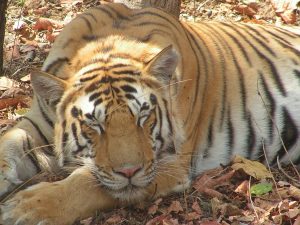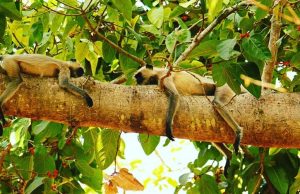Posted by on 29th July, 2018.
A naturalist is one of the most critical elements of your safari. The understanding, knowledge and instinct that one learns from being within the forest on a daily basis, are the key takeaways that distinguish a good naturalist. While large predators are certainly a huge highlight, the entire forest, right down to the smallest insect and the tiniest bit of moss and lichen, adds its own beauty to the setting.

The jungle is so many things. It’s a haven for biodiversity. A tranquil retreat away from urban life. It triggers creativity. It makes you realise how every being is linked to one another. It’s nature at it’s rawest – the guardian of our very existence.
But most of all, it’s a terrific teacher. Lessons from the wild are lessons for life – and encouraging the next generation to protect the delicate balance between flora and fauna, is essential. While traditionally being a naturalist has been a male dominion, women are now taking initiative to become naturalists as well.
Tigris Safaris talks to Ratna Singh, one of India’s first female naturalists, to learn a little bit about what inspires her in India’s jungles.
Tigris Safaris: What was your original inspiration to be one of India’s first (and foremost) female naturalists? Do you feel that more girls are being encouraged to take up natural sciences and biodiversity conservation as an area of study?
Ratna Singh: I have always liked animals and the jungles. Actually when I signed up for the training, I had no clue that there were no professionally qualified women naturalists in the wildlife tourism sector. Besides, in all honesty, India did not even a professional training programme to be a naturalist before Tajsafaris & AndBeyond moved into this field. The professional training was an import from South Africa and adapted to Indian conditions. Yes, I do think many more girls are taking to the wilderness and finding employment in the tourism sector.
The Indian Subcontinent’s topography and geography is among the most diverse in the world. From the Alpine Montane forests to tropical rainforest, wetland wilderness, to unique grasslands, to rocky ravines. Our wildlife is not limited to mammals alone. India’s bird life is some of the most diverse in the world – in fact, over 25% of the birds in the Indian Subcontinent are endemic to the region. That’s not all. Reptiles and amphibians abound, and in fact, new species continue to be discovered. Insects and arachnids form a huge part of our fauna – from spiders to butterflies, several extremely rare and beautiful species are only found here. Honing a sense of understanding, appreciation and the knowledge of conservation of this vast range of biodiversity and species is key.
Tigris Safaris: If you had to pick your top three national parks in India, which ones would you pick and why?
Ratna Singh: My top three parks and not in order of preference would be Kanha in Madhya Pradesh (Central India), because the of the cool sal forest, the enormous grasslands, fabulous bio diversity as well as the local culture – which is very distinct.
Bandhavgarh in Madhya Pradesh again, because that’s the park closest to my home and it’s where I received training. Besides, the undulating landscapes, the fort as well as other historical caves and statues add to the thrill of a tiger safari.
Dachigham National Park, in Jammu & Kashmir. It’s not far from Srinagar and sadly it’s not very easy to get permissions to enter. Set in the Himalayas, one mostly walks up or down, its exhilarating to be able to explore The hills, the grasslands and the coniferous forest on foot. The Hangul deer as well as the Himalayan Black bears are some of the iconic animals in this park. I spent a whole week walking about and there wasn’t a single other tourist! To see animals and birds feasting on the wild apples, pears and strawberries gave the park such a fairy tale quality.
The high peaks of the Himalayas are home to an abundance of rare flora and fauna. From the Valley of the Flowers, to the butterflies of Lahaul and Spiti, the migratory birds in the North East, to the Ibex and Snow Leopards of Ladakh – the mountain regions of the subcontinent are spellbinding. One of our favourite national parks in the country is Corbett National Park, which is situated among the foothills of the Himalayas in Kumaon. Corbett is a haven for tigers, wild elephants, Himalayan Bears, the Great Indian Hornbill, the Mahseer, and thousands of other incredible species that make it the visit of a lifetime. The rugged landscape only enhances the experience. Dense forests, snow fed streams that turn into gushing river beds, the mountains outlined in the background, a sky tinted rose by the sunrise…

Tigris Safaris: Can you share a single incident from among your wildlife experiences that is most vivid or memorable?
Ratna Singh: So many, but rather than the adrenaline rush stories, here is an amusing one. The actor Rahul Bose is a huge wildlife buff. He enjoys nature as a whole, so it was such a joy to be guiding him in the park. Our agenda for the safaris, was simple: birds, wildflowers, avoid other vehicles, no chasing predators, just enjoy the wonderful jungle.
So, as we chatted and languidly drove around the forest, we came across a cluster of vehicles waiting with expectation and some anxiety for a tiger to emerge. They had heard alarm calls half an hour ago, and this was a popular track for the tigress in that area to take. Anyhow, we decided not to wait, and carried on. Barely 10 minutes after leaving the melee, we came across the tigress sauntering across our path! She had given the others a slip and we were the only lucky ones to spot a tiger that morning.
So often, it’s more like the tiger has you in it’s sights – rather than the other way around. Sighting a tiger is a matter of chance. Very often, the animal may be within a few hundred feet, but it lies completely camouflaged by the landscape. Tigers are prone to resting within dense tufts of grassland, their stripes merging with the blades of grass so well, that you can barely spot the animal in it’s midst!
Tigris Safaris: What are your top take always from observing animals in the wild – intellectually, physically, and spiritually?
Ratna Singh: Intellectually – Self-awareness , I think only an intelligent beings have that level of self-knowledge.
Physically – fitness! Seriously one cannot afford to take your life for granted.
Spiritually – Live in the moment, mind your own business, take only what is essential.
The jungle is the world’s best classroom – simply sitting still and watching nature unfold before your eyes teaches you untold lessons in parenting, strategy, timing, patience, balance, wellbeing, and so many other elements of our daily life.

Tigris Safaris: How important a role does a pioneer species like the tiger or the elephant play in preserving the ecological balance?
Ratna Singh: Tigers are mascots really. Because, protecting tiger habitat automatically shelters all the other fauna and flora which form the complex tapestry to keep nature in balance. Most of our rivers are forest fed, jungles bring down temperatures, cause rain, soak up carbon…the list is endless. Seriously, leave alone protecting elephants or tigers, if humans want to live decent lives, they have to safeguard the wilderness for themselves.
We may think of ourselves as guardians of the forest – but really, it’s the forest that guards us, provides for us, and nurtures us. A terrific naturalist is one who not only imparts his or her knowledge about the forest to you, but inspires you to play an active role in it’s wellbeing.

India’s species are one of a kind and a safari in India is the experience of a lifetime. Reach out to Tigris Safaris today to plan your safari in the Indian Subcontinent.
Photo Credits: Ratna Singh